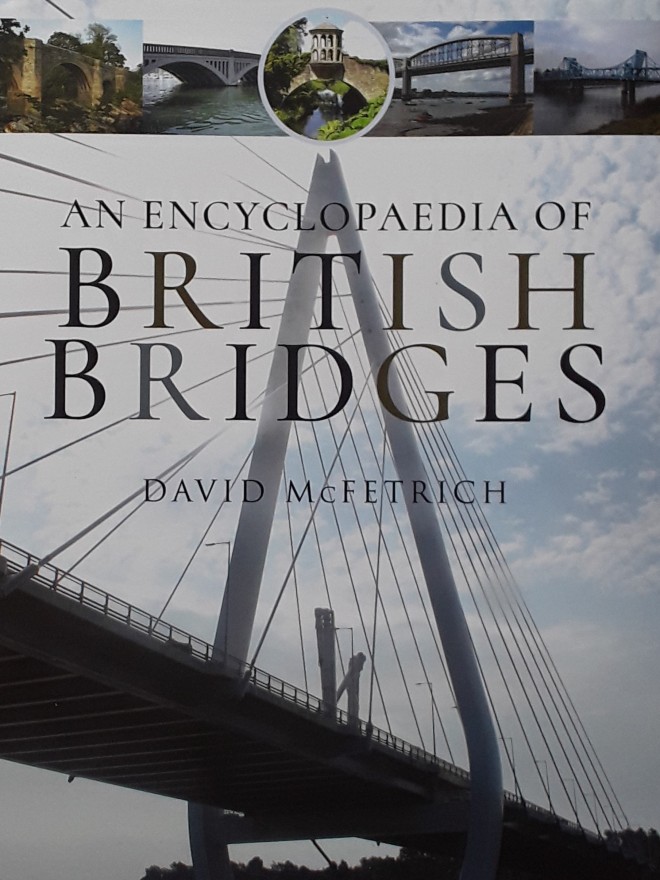
Reviewer: Michael Keith
Title: An Encyclopaedia Of British Bridges
Author: David McFetrich
Total Number of Printed Pages: 444
Rating Scale (1: Very Poor, 10: Excellent): 9
__________________
When writing in thus volume’s Introduction, the author states that ‘The purpose of this book is to give some outline facts about as many interesting bridges and types of bridges as possible’. It is a reasonable summation of what is to follow and has resulted in a work that is remarkable in the depth of its coverage of its subject.
It should be noted that this is a second edition of a work believed to have been previously published in approximately 2011.
In common with many such encyclopaedic works, this volume contains no Contents page, with the first formal section being a Foreword placed after its Title Page. This is followed by a section titled Introduction. This section is a multi-faceted and contains three subsections. Included in these is a Preface to Second Edition [sic], a Brief History of Britain’s Transport Infrastructure and How Bridges Work. The titles are self-explanatory. The Introduction is followed by a comprehensive and very informative Glossary and a section titled List of Abbreviations to Common References. The section’s sub-title is Books and pamphlets (see the Bibliography for full details) and while the title of the Glossary is again self-explanatory, the latter is anything but. Numerous published resources were used in the preparation of this book, and to save readers the need to constantly refer to the Bibliography, the titles of said resources have been reduced to multi-letter abbreviations and placed after each individual ‘Bridge’ entry within the volume. The section titled List of Abbreviations to Common References is the result and contains the majority of the abbreviations appearing within the volume. The section is followed by one titled The Bridges, which, although containing no text itself, carries a subsection bearing the title Notes. Within this, the format used for the individual bridge entries is defined. The 311 pages comprising the bulk of the volume now appear. According to the author, the section contains 1,600 individual entries, and ‘Allowing for entries that give details of predecessor bridges or several co-related bridges at one site, there is information describing more than 2,200 different structures.’ In that context, it should be noted that structures such as piers have also been included in the list, the rationale for such inclusions being that they are ‘…Effectively one-ended bridges.’ As would be expected, the individual entries are arranged alphabetically, with the majority of the entries being accompanied by a monochrome or colour image of the structure being discussed. The entries are informative and follow a standard format. This consists of a history of the site and, if replaced, the structure as it currently exists and, where known, its dimensions. One or more of the previously-mentioned abbreviations appears at the end of each entry. The section is followed by another titled Bridge Miscellany. This is a 52-page section best summarised as being ‘All the things you might need to know about Bridges and never thought to ask’; a catch-all of information about bridges in general and British bridges in particular.. Within it, the subjects range from Aesthetics of bridges to Pageantry on bridges to Zigzag bridges, with each entry, after defining its subject, and where applicable, giving examples of where the item may be found within the British Isles. A section titled Record Breaking Bridges follows the ‘Miscellany; its title being self-explanatory. This section contains 50 sub-sections and is largely United Kingdom-focussed. However, and due to the paucity of such bridges in Britain, the majority of entries in Subsection 49 (World’s longest single spans) consists of entries from Europe, Asia and North America. A four-page Bibliography follows and is in turn followed by a 30-page Geographic Index. Amongst other things, this comprehensive section enables readers to locate the structure, its geographical location, and historical status. It is followed by the volume’s General Index. Within this and ’To save space…names and words appearing within the Bridge Miscellany are not repeated within this index, which is limited to the main bridge entries on pages 23 to 234.’ The Index entries are divided into subsections, a detail which pre-supposes that a reader actually knows the type of bridge he is looking for; many may not. An Acknowledgements section follows the Index; it is the volume’s final section. Within it the author provides reprints the biographical details relating to his interest in bridges which appeared in the book’s first edition, acknowledges those who assisted in the upgrading and publication of the second edition, and provides sources for the images that appear within it. Where appropriate to the narrative, the volume uses Tables, Diagrams, Plans and Drawings to clarify technical terms or provide additional information. Curiously, it contains no Maps.
This volume is well-written and researched and eminently readable, to the extent that this reviewer could find little to fault it. The comments made previously about the use of subheadings within the Index do however still stand, while the absence of any Maps would seem to impose unnecessary limitations on those wishing to view the structures mentioned within the volume; if a reader can’t locate an item they will be unable to visit it should they so desire. The use of Grid References pre-supposes an ability to know what they are and how to use them; many readers may not have that ability or inclination.
Because of the ubiquity of bridges throughout Great Britain, this volume should have wide appeal. Being an encyclopaedia, it is eminently suitable for random ‘dipping-type’ subject- searching and would be entertaining on that basis alone. Historians and those interested in bridges in both civil-engineering and general interest areas may find it of interest, while readers seeking information about a local bridge-type structure may also find it worthy of their attention.
On a Rating Scale where 1: Very Poor, 10: Excellent, I have given this volume a 9.
__________________________________
